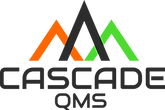If you’re a contractor, vendor, or supplier working with Kinder Morgan, you’ve likely received a request to upload a Flagger and/or Spotter Safety Program to ISNetworld. While this may seem like a routine compliance task, it carries significant weight for your business—especially if you want to continue working with Kinder Morgan and similar clients who take workplace safety seriously.
At Cascade QMS, we help companies navigate these requirements by providing custom safety programs—including a fully compliant Flagger and Spotter Safety Program—that meet ISNetworld’s Review and Verification Services (RAVS®) standards. This blog will walk you through what the requirement means, why it matters, and how we can support you every step of the way.
What Is ISNetworld and Why Are Kinder Morgan Contractors Being Asked for a Flagger/Spotter Safety Program?
ISNetworld is a widely used contractor management platform that connects hiring clients like Kinder Morgan with qualified, safe, and reliable contractors and vendors. One of the main components of ISNetworld is the RAVS® (Review and Verification Services) section, where contractors submit their written health, safety, and environmental programs for review.
Kinder Morgan now requires all contractors, suppliers, and vendors to submit a Flagger and Spotter Safety Program as part of their ISNetworld compliance documentation. This request reflects the company’s focus on improving job site safety and ensuring that everyone working under their name follows the same high standards.
But submitting a safety program to ISNetworld isn’t as simple as uploading a Word document. Your submission must meet specific formatting and content requirements, often based on OSHA regulations, best practices, and client-specific needs. That’s where Cascade QMS comes in.
Why Are Flagger and Spotter Safety Programs So Important?
Flaggers and spotters are essential on any worksite involving vehicle or equipment movement—especially in industries like construction, pipeline, and energy where heavy machinery and low visibility create serious safety risks.
Here’s why your Flagger and Spotter Safety Program needs to be solid:
- Prevents collisions and injuries: Spotters help guide equipment operators and ensure blind spots are covered. Flaggers manage traffic flow and help prevent accidents involving pedestrians or passing vehicles.
- Ensures regulatory compliance: A written safety program demonstrates that you’re aware of, and compliant with, industry safety standards.
- Builds trust with clients like Kinder Morgan: Meeting or exceeding safety expectations shows that your company is professional, prepared, and serious about protecting its workforce.
By requiring contractors to submit this safety program to ISNetworld, Kinder Morgan is emphasizing a culture of accountability and safety. Contractors that meet these requirements are more likely to be selected for future work and maintain long-term client relationships.
Flagger Safety Steps
Flaggers are responsible for managing traffic flow and ensuring the safety of workers and motorists. To perform their duties effectively, flaggers should follow these steps:
- Wear High-Visibility Gear: Flaggers must wear ANSI-compliant reflective clothing to ensure visibility in all conditions, day or night.
- Use Proper Tools: STOP/SLOW paddles, flags, and clear signage are essential for directing traffic safely.
- Position Strategically: Flaggers should stand far enough from the work zone to give drivers time to react, while also ensuring they have an escape route in case of emergencies.
- Stay Alert: Constant vigilance is crucial. Flaggers must remain focused on their surroundings and be prepared to respond to sudden changes in traffic or site conditions.
- Communicate Clearly: Using standardized hand signals and clear signage helps prevent confusion and ensures smooth traffic flow.
Spotter Safety Steps
Spotters act as the eyes and ears for equipment operators, ensuring safe maneuvering and preventing accidents. To maximize safety, spotters should adhere to these steps:
- Establish Clear Communication: Spotters and operators should agree on standardized hand signals or use radios to maintain constant communication.
- Maintain Visibility: Spotters must stay in the operator’s line of sight at all times. If visibility is lost, the operator should stop immediately.
- Monitor Hazards: Spotters should identify potential risks, such as overhead power lines, blind spots, and nearby workers, and provide timely warnings to operators.
- Avoid Distractions: Spotters must remain fully focused on their task, avoiding the use of mobile phones or other distractions.
- Wear Appropriate PPE: High-visibility clothing, hard hats, and gloves are essential for spotters to stay safe and visible.
Why These Safety Steps Matter
Adhering to these safety steps is not just about compliance—it’s about creating a culture of safety. By following these protocols, flaggers and spotters can:
- Reduce the risk of accidents and injuries.
- Protect workers, equipment, and the public.
- Ensure smooth and efficient operations on job sites.
Other Helpful Resources
Here are some valuable resources to further enhance your understanding of flagger and spotter safety and Kinder Morgan’s compliance expectations. These links provide in-depth information and guidelines that can help you develop and implement a robust safety program:
- OSHA Guidelines on Preventing Backovers: Learn essential backover prevention practices for spotters.
- Flagger Safety Manual: Detailed safety guidelines for flaggers, including training and equipment requirements.
- Kinder Morgan Contractor Safety Compliance: Detailed information on Kinder Morgan’s contractor safety program and ISNetworld requirements.
What Happens If You Don’t Submit the Right Program?
Failing to submit a compliant Flagger and Spotter Safety Program can impact your standing with Kinder Morgan on ISNetworld. In some cases, contractors risk being marked as non-compliant, which can delay projects, disqualify bids, or even lead to removal from approved contractor lists.
Unfortunately, many contractors attempt to create or submit their own safety programs without fully understanding how to submit a RAVS® assessment under the proper guidelines. This can result in rejected submissions and lost time.
How Cascade QMS Can Help You Get ISNetworld Compliant—Fast
At Cascade QMS, we specialize in ISNetworld RAVS® compliance services. Our team understands what Kinder Morgan (and other clients) expect and what ISNetworld looks for in a Flagger and Spotter Safety Program.
Here’s how we help contractors like you:
✅ Custom-Written Safety Programs: We don’t just give you a generic template. We create a program tailored to your specific work activities and risk exposures—ensuring it meets client expectations and ISNetworld formatting.
✅ RAVS®-Ready Documentation: Our safety programs are built to pass ISNetworld’s verification process the first time. That means fewer delays, faster approvals, and better compliance scores.
✅ ISNetworld Management Services: Beyond the Flagger and Spotter Safety Program, we can manage your entire ISNetworld profile, including document uploads, client connections, compliance monitoring, and more.
✅ Ongoing Support: If anything changes with Kinder Morgan’s requirements, we’re here to update your documentation and keep your profile current.
Don’t Let Compliance Hold You Back—Let Us Handle It for You
Submitting a compliant Flagger and Spotter Safety Program to ISNetworld is more than a one-time task—it’s part of maintaining a professional reputation and staying competitive in the industries Kinder Morgan serves. At Cascade QMS, we make it simple. Our compliance experts work quickly and efficiently to create safety programs that not only meet ISNetworld standards but also support a culture of safety in your organization.
Ready to get started?
Learn more about our ISNetworld Management Services. Or contact us today to get your Flagger and Spotter Safety Program done right—the first time.

